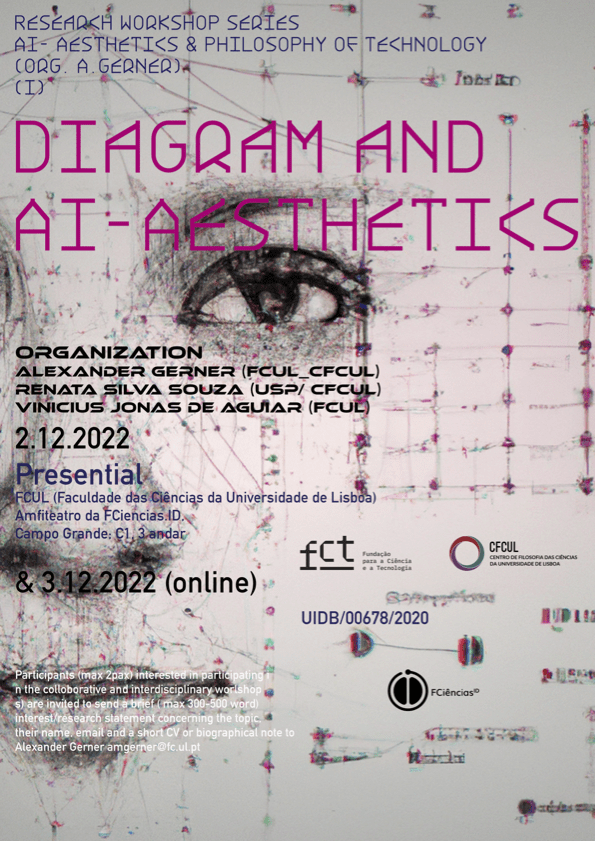
“Diagram and AI-Aesthetics”
Part One: 2.12.2022 (embodied/ “in the flesh”) , FCiências.ID, Ciências ULisboa, Campo Grande, Lisboa
Including a book session with Frederik Stjernfelt: “Sheets, Diagrams, and Realism in Peirce”
Part Two: 3.12.2022 (virtual/online, Zoom)
“For it is evident that it is in esthetics that we ought to seek for the deepest characteristics of normative science, since esthetics, in dealing with the very ideal itself whose mere materialization engrosses the attention of practics and of logic, must contain the heart, soul, and spirit of normative science.” Peirce (1906, CP 5.551).
What role does diagrammatic perception (aisthesis), diagrammatic manipulation (techné), or diagram construction(poesis) play in aesthetics? Did the aesthetic relation between human beings and machines recently change? Independently of the question if AI will or will never (Smith & Landgrebe 2022) rule the world, we want to ask: How is human creative behavior and issues of aesthetics simulated, co-generated, or mimicked with the help of diagram- technologies and theoretically staged in diagram strategies/dramaturgies in AI aesthetics? If AI is conceived as imitation engine of collective intelligence (“We are AI“H.Herndon), what role do aesthetics and diagram play when considering topics of AI aesthetics, and how could a Peircean account of the diagram elucidate questions about AI aesthetics? How do (collective) aesthetic strategies that work with AI and machine learning tools use diagrammatic typification and simplification, e.g., in generating or applying aesthetic styles? Do artistic strategies of aesthetic blurring, ambiguity, and abstraction via Ai-apps mean more or reduced diagrammaticity? Can diagrams elucidate Machine learning ́s hidden layers (“black boxes”)? Does Ai aesthetic reduce aesthetics complexity to makable design problems (Does Ai aesthetic reduce aesthetics complexity to makable design problems (e.g. design to overcome the uncanny valley, design for social interaction, design for empathy, design of mimetic doubles/automata/human-AI-systems)? Are aesthetic style and design hacking a form of diagramming?
The question of the mere ontological (im-)possibility of “the” creative machine does usually obfuscate the performative and cultural changes emerging from collaborative collective human-AI aesthetics. Holly Herndon’s spawning would be an example of “Designing and implementing solutions using collective intelligence and augmented technology“ Stability.AI) in which ownership of training data use and access to large AI models, aesthetics and public permission are renegotiated. Human-machine interaction, such as in synthetic media working with large (multimodal) language models and text-generators (GPT-3 or other transformer models such as the Code/language translator “OpenAI Codex”) and text-to-image generators, (NFT) art generators and enhancers (Dall-E 2; Imagen; Jasper.AI; Deep Dream Generator; StarryAI; Craiyon; Nightcafe; Photosonic; MidJourney; Stable Diffusion), music/audio generators (Amper, Aiva, Sounddraw, Boomy, Amadeus Code), music/voice (collective) “AI’s” (Magenta; Holly+ DAO, spawning) put forward questions of control of randomness (classical, quantum, computational, algorithmic, and biological; Longo 2010; Longo’s letter to Alan Turing 2018) -randomness sampling creativity parameters (e.g. InferKIT) or models trained to score judging “aesthetically pleasing” outcomes(LAION- Aesthetics V1)- recent computational approaches including quantum computer music (Miranda & Basak 2021; 2022) using random walks and Markov chains and other algorithmic developments of technologies such as machine learning, deep learning (CNN, RNN, GAN, Autoencoder, VAE, Transfer Learning), one shot learning, hybrid learning, among technological applications (such as 3D modeling, epipolar geometry) and other diagrammatic approaches to (multimodal and dia-) aesthetics force us to reflect how music, sounds, images, texts, sensible and (abductive) perceptive judgements and also the ubiquity of digital (or smart) diagramming systems mapped from bodies or synthetically multimodally generate data-driven Digital twins, AI Avatars change aesthetical categories or collective strategies and improvisation charade games?
Do improvisatory gestures generate ontological novelty and breach combinatoric/creative barriers? Is computational art diagrammatic, focusing its attention on objects and its spatial-temporal or political relations to actions? Apps of facial recognition for security, law enforcement, and marketing as well transform facial appearance and self-image by algorithmic filters such as Cymera, Deepfacelab, facetune, face app and Snapchat that change the physical appearance and the situated impact they have on people’s self-image. Those technological transformations pose unavoidable questions that demand inputs from various disciplines and sciences, including aesthetics and semiotics. Today we witness a proliferation of prompt engineering, and massive growth of using recommender systems, multimodal language, gesture and image generators, synthetic media, and other data-and algorithm-driven (artificial) creativity platforms. The problem of relevance and visibility, be it in health, economy, entertainment, or scientific knowledge, is more and more often translated into a data science problem and dealt with in those terms. This raises relevant questions concerning, for example, algorithmic politics, programmed sociality of actions, commodification, discrimination, self-perception, and observation, and “participation without democracy “(Faßler 2018) (e.g., how AI can be an “interpretant” of individuals, groups, societies ( and their preferences or biases) and how we are using these technical systems to redefine aesthetics, ethics, politics, science and the social, but also concerning the future of cultural industries, creativity, perception/observation, imagination and collaborative improvisation as well as manipulation of AI tools. Will our AI-driven strategies- however- actually change questions of creativity, abduction, habit change, novelty, values, discovery, meaning, and aesthetics?
In this endeavor we can understand diagrams as a crucial topic of exploratory activity in knowledge and experience augmentation and growth and perceptive-action or perspective transformations, as well as communicative rhetoric at the core and the actuality of a Peircean age. The question is whether or not the Philosophy of the diagram at the outset leads to a model-based science (diagrammatic reasoning in models) of science, logical graphs, or also includes aesthetics. We are interested in the relation of aesthetics and art forms and diagrams as a perceptual and conceptual science of boundaries, limits, and mediation that deals with the “dia-” of the diagram.
Info
This is a split (not hybrid) live (2.12.2022) and virtual/online workshop (3.12.2022). Active Participants (max. 25) interested in participating in this collaborative workshop of the Philosophy of Human Technology research line of CFCUL are invited to send a brief (max. 300- 500 words) interest/research statement concerning the topic, their name, email, and a short CV or biographical note to Alexander Gerner amgerner@fc.ul.pt